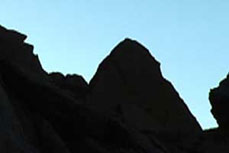
|
||||||
|
|
||||||
|
|
|
|
|
|
|
|
|
|
||||||
Piedra del Sol Piedra del Sol (literally, "rock of the sun") is a large boulder not far from the visitor center at Chaco Canyon. Pecked into this boulder is a petroglyph in the shape of concentric circles, a symbol thought to represent the sun. Standing with your back to this petroglyph , you see a distinct triangular rock before you. The sun appears to rise from the tip of this rock exactly two weeks before summer solstice . Nearby pecked basins, in which corn would have been ground for ceremonial offerings to the sun, support the theory that this site was used for observing and offering prayers to the sun. 
There is another petroglyph of interest at Piedra del Sol, which some people believe to be a representation of a total solar eclipse that happened in July of AD 1097. The wavy tendrils extending from the central circle could have been matter blown out from the sun’s corona—a coronal mass ejection —made temporarily visible by the eclipsing of the bright solar disk. Lending some credence to this speculation is the fact that AD 1097 coincides with a period of intense solar activity, known as the Medieval maximum, which took place from AD 1000 to AD 1300. The great kiva Casa Rinconada is a circular structure, half-sunk into the earth on a hill. Kivas are ceremonial places in Pueblo culture, as well as symbols of the cosmos. Aligned with the cardinal directions, the line connecting the north and south doors to Casa Rinconada is within one third of a degree of true north. 
A compelling but contested alignment exists within Casa Rinconada. At sunrise on the summer solstice, a beam of light from a northeastern opening in the kiva precisely illuminates a niche in the far wall. The niche in question is one of many, however, it is only one of several that are uniquely placed. Several facts complicate the possibility that this alignment was intended and observed by the ancient Chacoan builders. The kiva was partially reconstructed in 1933, and its exact original plan is unknown. A room exterior to the crucial opening may or may not have existed, and may or may not have blocked the shaft of light. There is also some evidence of support beams (now missing) and other structures in the room that may have blocked the light |
||||||